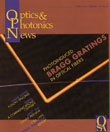
February 1994 Issue
Feature Articles
Fiber Optic Fusion Splicing:Two Technologies Compared
When fiber optic cables are installed or repaired, splicing is by far the most common method of joining any two fibers together. Whether fusion or mechanical splicing is used, the goal is to join the tips of the two fibers together, end-to-end, in a permanent manner. The most important criteria for a good fiber splice is low insertion loss (the amount of light lost at the junction, relative to what would cross if the fiber were continuous), back reflection from any features in the junction, and the stability of the splice over an extended time at normally varying ambient temperature.
by Todd Norton and Joseph GearyVisions From the Top of a Swing Set: Visibility for Kids, Part 2
This article is the second in a pair to provide ideas for helping youngsters understand the limits to visibility. Last month (January OPN, page 66), I suggested showing youngsters that the atmosphere can affect how far you see by introducing the concept of path radiance, or airlight. I gave several examples of ways to observe the naturally occurring path radiance in the atmosphere, and included experiments demonstrating that the path radiance depends on several variables, such as the amount and character of the scattering medium.
by Janet ShieldsTwo Effective Methods of Optical Transfer Testing
When ISO/TCI72/SC1/WG1, the standards committees working on optical testing, started writing standards in the early 1980s, the work was concerned almost exclusively with optical transfer (OTF) testing of optical systems. Now that the other subcommittees in TC172 are beginning to write performance standards for various tests of optical instruments, there has been a mindset to write resolution standards in terms of the OTF because, among other things, an ISO standard exists for making these measurements.
by Robert E. ParksThrough the Looking Door
One common type of lens with which almost everyone is familiar is the simple door viewer ("peephole"), which allows a homeowner or hotel room occupant to view a wide field through a small hole in the door while preventing anyone from seeing in through the viewer.
by Roy YoumanPhotoinduced Bragg Gratings in Optical Fibers
Many important advancements have been made in grating technology since 1978, when K.O. Hill and his colleagues first observed a photoinduced grating in a germania-doped optical fiber. Hill's gratings were made in the fiber core by a standing wave of 488 nm argon laser light. The grating exposure in this case was shown to be a two-photon process. The next major advancement in grating technology was to make a transverse exposure on the side of the fiber with an interference pattern formed with an intense UV laser source to produce the index modulation or phase grating in the fiber core. The UV exposure gave a single-photon process with an enhancement of a million times in the photosensitivity of the grating writing process compared to the use of visible laser light.
by William W. Morey, Gary A. Ball, and Gerald Meltz

![A multiplexed image of a human tonsil acquired. [NIAID] using the iterative bleaching extends multiplexity (IBEX) method.](https://opnmedia.blob.core.windows.net/$web/opn/media/images/articles/2024/0424/departments/202404-cover-web.jpg?ext=.jpg)
